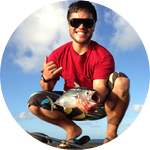About This Project
Ciguatera is a common seafood borne illness caused by consuming tropical and sub tropical reef fish. There is no reliable method of detecting ciguatoxin presently available to the public. I want to compare ciguatoxin (CTX) incidence and concentration in Peacock grouper (Cephalopholis argus) from the east and west shores of Hawaii island to determine if there is any spacial variation in the toxins presence in reef fish. This will help inform fishers and consumers on where to source their fish.
Ask the Scientists
Join The DiscussionWhat is the context of this research?
Ciguatera fish poisoning affects 10,000-500,000 people each year. Ciguatoxin is tasteless, odorless, and colorless, meaning it cannot be detected by conventional methods available to the public(Bienfang et al. 2012). It also is a very stable molecule, it cannot be degraded by cooking, freezing, drying or, salting (Hirama et al. 2001). Prevention lies in knowing the causal factors of CTX. These could be fish species, location, water temperature, depth, size etc.. Without solid scientific evidence of these factors correlating to CFP and CTX, we cannot know what to avoid.
With increasing temperatures due to global climate change, the organisms producing CTX (G. toxicus) may become more prevalent producing more toxins (now more than ever is an experiment like this needed(Tester et al. 2010).
What is the significance of this project?
With increasing temperatures due to global climate change, the organisms producing CTX (G. toxicus) may become more prevalent producing more toxins (now more than ever is an experiment like this needed(Tester et al. 2010). In conducting this experiment, we can provide communities in Hawaii with information that can influence good health, and fishing practices. If successful, this project can be a blueprint of future project in the state of Hawaii, and in tropical/sub-tropical locations around the world.
What are the goals of the project?
The goal of this project is to determine causal factors of CFP, and CTX positive fish. Knowing these factors can decrease the chances of someone eating a contaminated fish, while promoting a healthy reef fishery.
Budget
Gasoline is needed to commute from Hilo to Kona each week to collect samples. 10 -15 trips at $50 gas per trip. Ice is needed to preserve fish samples while commuting and processing. Tackle is needed to catch fish. This will be done via freedive spearfishing. Speargun-$300, Line $20, Reel $50, Bands -$30, Float -$100, Float line- $50, Terminal (replacing gear) -$50.
Travel costs include flights to Oahu island. This will allow myself and my advisor to meet with our collaborating entities (toxicology lab).
Processing samples requires containers to store tissue, as well as adequate equipment to process fish, Knives, processing trays, bags, water. etc...
Meet the Team
Joshua La Pinta
I am an undergraduate senior at the University of Hawaii at Hilo perusing my BA in Marine science and a minor in Anthropology. I was born and raised in Hawaii, fishing, diving, hunting and eating. I intend to pursue a career in fisheries science/management as well as public and community education on this subject.
Lab Notes
Nothing posted yet.
Project Backers
- 2Backers
- 2%Funded
- $29Total Donations
- $14.50Average Donation
